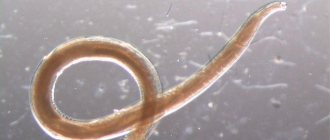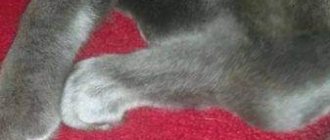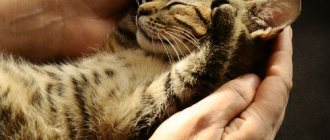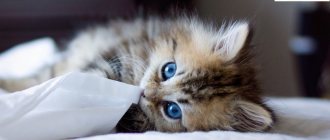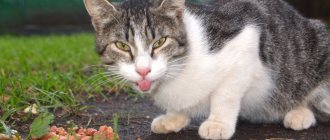Feline calcivirosis is an acute infection, in severe cases leading to the death of the patient. It is not transmitted to other pets and humans, but in cats it causes inflammation of the conjunctiva of the eyes, the oral mucosa, spreading to the respiratory organs. Antiviral vaccination, as well as timely, properly selected treatment contribute to an almost complete cure.
How dangerous is the disease for animals?
The main target for calcivirus infection is the respiratory tract.
An animal infected with the virus becomes depressed, has a dry cough, nasal discharge, and wheezing when breathing.
The lack of timely veterinary care leads to the development of serious complications - inflammatory processes in the bronchial tree and pulmonary structures. The possibility of penetration of the calcivirus virus into the meninges cannot be ruled out.
Taking this into account, the main dangers of this disease for a cat are:
- the consequence of the disease in a cat can be death from suffocation or exhaustion;
- the disease is easily transmitted, so if there are several cats in the house, they will all very quickly become infected with this disease in the absence of treatment and non-compliance with preventive measures;
The most difficult course of infection is in small kittens due to the fact that their immune system is not fully developed.
Possible complications
In most cases, calcivirosis is complicated by a bacterial infection. The probability of death increases to 60%. Other complications of feline calcivirus infection:
- pneumonia;
- dehydration;
- tooth loss due to gum inflammation;
- renal failure in chronic course.
Ways of infection of cats with calcivirus
Infection of a pet occurs in several ways:
- nutritional (with food and water);
- airborne.
The disease affects a cat through direct contact of a sick animal with a carrier of the infection. In a virus carrier, the disease may occur in a latent form, but the infection process occurs in full.
The risk of contracting calcivirus increases when transporting an animal on public transport or when being close to sick cats.
Infection occurs with a 100% guarantee if a healthy cat comes into contact with a sick animal that shows signs of calcivirosis.
The infectious agent is released into the environment along with mucous discharge from the nose, mouth and eyes. Penetrating the mucous membranes of a healthy cat, the calcivirus begins to penetrate the epithelial tissue, actively multiplying.
The alimentary route of infection is characterized by the entry of viral agents into the animal’s body through contact with infected feed, trays with filler, and through bowls of food and water.
What is feline calicivirus
The FCV virus is the cause of most respiratory diseases in cats. The virus is stable and quickly adapts to environmental conditions, which complicates the development of a sustainable vaccine.
Calcivirus is quite common among cats. Approximately 10% of pets have calcivirus or are carriers of it. In shelters and nurseries this figure can reach 25-40%. The body of a sick animal releases the virus along with saliva, urine and feces. It is also transmitted by airborne droplets.
Risk group
Calcivirosis is very dangerous only for kittens, unvaccinated adult cats and weakened elderly animals, since the body's resistance to this category of animals is significantly reduced.
The mortality rate from calcivirosis in kittens and older animals ranges from 15 to 30%.
The virus does not pose a danger to humans and other types of domestic animals.
Important!
Start antiviral therapy in a timely manner - with proper treatment, the animal will recover.
Symptoms of calcivirosis
The main organs affected by the infection are the nasopharynx and respiratory tract. A cat with calcivirus infection is depressed and sneezing and coughing. The manifestation of the disease is most pronounced in small kittens with an unstable immune response.
Symptoms of calcivirus infection:
- fever, accompanied by a sharp increase in the pet’s body temperature (indicators exceed 40 degrees and can last 2-3 days);
- discharge from the nasal passages, discharge from the nasolacrimal ducts, saliva from the mouth (a sign of calcivirosis is wet fur in the chin area);
- ulcerative lesions and abscesses in the form of bubbles with liquid, located in the area of the palate, tongue and gums;
- a hysterical cough, reminiscent of a process when an animal swallows food copiously and gags;
- inflammatory changes in the gums (hyperemia and swelling);
- the formation of ulcers on the cat’s nose and mouth, which take a long time to heal and cause severe discomfort to the pet;
- the appearance of a repulsive fetid (putrid) odor from the mouth;
- breathing problems, sounds of gurgling liquid;
- swelling of the pulmonary structures.
If the animal has a strong immune system, there are practically no symptoms of calcivirus infection.
In immunocompromised cats and kittens, calcivirus can cause serious complications, including death.
Description of the disease
The disease is caused by the Feline calicivirus (FCV). It affects the upper respiratory tract and oral mucosa. Feline calcivirus is registered all over the world, including in Russia. It affects domestic and wild representatives of the cat family. There is no breed selectivity for this infection. Calcivirus is one of the most common causes of upper respiratory tract diseases in cats (along with the herpes virus). Kittens over 2 months old and young kittens up to 2 years old are susceptible. They make up about 90% of the total number of sick animals.
On a note! If the cat is vaccinated against calcivirus infection, then suckling kittens will be protected from infection during the period of feeding with cat milk.
Calcivirus has many variants (more than 40 strains are known). During reproduction, the pathogen exhibits high variability. In this respect, it is similar to the human influenza virus. Strains of the virus differ in symptoms and severity of the disease. Calcivirosis is considered a mild infection. It is dangerous for small kittens, animals with weakened immune systems, old cats or those with chronic diseases. Cats become infected with calcivirus infection throughout the year. The peak incidence occurs in the autumn-winter period.
Diagnostics
An accurate diagnosis can only be made in a veterinary clinic.
Diagnosis is difficult due to the similarity of the symptoms of calcivirosis with other infectious diseases (herpes virus infection, chlamydia, bordetellosis).
In addition to a thorough clinical examination, the veterinarian prescribes a number of laboratory tests:
- general clinical analysis of blood and urine;
- serological diagnostics;
- bacterial inoculation on nutrient media of nasal swabs.
Complex cases of calcivirosis require detailed study.
Differentiation is carried out if the development of viral leukemia in a cat, immunodeficiency, kidney or liver failure is suspected.
Treatment of calcivirosis in cats
Treatment of the cat begins immediately after visiting the clinic to alleviate the condition. Specific drugs are used to suppress the activity of viruses. In the presence of pathogenic bacterial microflora, therapy is carried out using antibiotics.
Symptomatic therapy includes the use of medications that have a supporting effect on the functioning of the immune system.
Immunomodulators enable the body's defenses to independently fight a viral infection. When diagnosing calcivirus in a small kitten, the treatment regimen includes the use of saline and glucose to prevent the development of dehydration.
It is necessary to introduce vitamin and mineral complexes. If a cat has been in contact with a known sick relative, it is recommended to administer Vitafel serum to prevent infection.
A veterinarian develops complex treatment based on laboratory data obtained. The animal is given rest and a balanced diet.
All diseases of a viral nature provoke the development of exhaustion of the body. Food during treatment and recovery for calcivirosis should be easily digestible and nutritious.
The place where the sick pet is located should always be clean and the room regularly ventilated.
Impact of the virus on people
Sometimes very frightening symptoms spread misinformation about the relationship between people and sick cats. This virus is not at all dangerous for owners, moreover, it will not cause any harm to dogs, horses and other animals. This strain is only related to cats. There is no need to be afraid of a sick pet; it needs to be treated; it needs the support and care of its owner.
All infections that affect an animal’s immune system are dangerous for it, but if you notice the symptoms in a timely manner and begin treatment, you can cope with this disease.
Treatment of calcivirosis at home
The basic task of the cat owner and veterinarian when calcivirosis is diagnosed in an animal is to alleviate suffering and eliminate symptoms.
Depending on the course of the disease and the severity of the lesions, therapy will vary.
For a long time, antimicrobial agents have been actively used in veterinary medicine to combat calcivirus infection. Now at this stage, drugs - immunomodulators - are actively used to combat infection.
After consultation with a specialist and confirmation of the diagnosis, treatment of the animal can continue at home.
Ulcers and wounds formed in the cat’s mouth must be regularly treated with special antiseptic solutions. A small kitten must be securely restrained, but care must be taken to ensure that the animal is not injured.
To securely hold your cat at home, you can use a thick blanket or any other fabric. The cat is wrapped in it so that it does not have the opportunity to escape and scratch the owner. Clean the eyes and nose from dried crusts using a cotton pad or gauze cloth previously soaked in the medicine. Special antibacterial drops are instilled into the eyes.
Due to inflammatory processes in the nose, the pet's sense of smell is greatly dulled, so the cat may refuse to eat. In this case, you need to be patient when forcing the cat to eat.
- Dry food can be pre-ground using a food processor or blender by adding broth or water.
- Having brought it to a pulp state, the resulting food is drawn into a syringe with the needle removed beforehand and given to the animal.
- Gently unclenching the pet's jaws, insert the tip of the syringe into the corner of the mouth and inject food.
- It is necessary to ensure that food comes in small portions, because this will make it much easier for the animal to swallow.
Calcivirus infection in cats can occur in several stages. The general condition of the animal will depend on this. A mild form of the disease is rarely diagnosed. More often, an acute form occurs, characterized by a sharp rise in body temperature, lethargy of the cat, and loss of appetite.
With timely vaccination, the risk of contracting calcivirus cannot be excluded, but the course of the infection is much easier, and the prognosis is always favorable.
Antibiotic therapy is prescribed to cats only if pathogenic bacterial microflora has been associated with a weakened immune system.
A treatment regimen at home should be drawn up by a qualified veterinarian. In general, the treatment regimen looks like this:
- prescribing antiviral drugs by injection;
- antibiotic therapy (if necessary);
- regular treatment of the affected mucous membranes of the mouth, nose and eyes with special antiseptic solutions;
- replenishment of fluid deficiency during the initial stages of dehydration (relevant for small kittens);
- general strengthening and maintenance of the body’s immune forces;
- properly organized diet;
- ensuring peace and proper care (changing bedding, ventilating the room).
The doctor prescribes medications to treat a viral infection based on the individual characteristics of the cat’s body and the degree of the disease.
Summary
- Calcivirosis in cats is a disease that is widespread throughout the world.
- There are respiratory and acute virulent systemic forms of calcivirosis.
- Kittens, unvaccinated animals, cats with chronic diseases, elderly pets, and cats kept in crowded conditions are most susceptible to the disease.
- The main signs of calcivirosis in cats: oral ulcers, fever, hypersalivation, anorexia, apathy.
- The diagnosis is made comprehensively: by collecting anamnesis, examining the animal, and laboratory diagnostics (PCR examination of swabs from the oropharynx, nasal cavity, and conjunctiva).
- The vaccine cannot provide 100% protection, but it can alleviate the course of the disease!
Features of treating a pregnant cat
In the absence of vaccination, a cat can develop calcivirus during the period of gestation.
Due to changes in the body, pregnant cats are more susceptible to the disease, and medications are selected that are as gentle as possible.
If left untreated, the risk of fetal death or the birth of non-viable offspring is extremely high.
About 80-85% of sick cats can spontaneously abort or give birth to stillborn kittens.
Consequence of the disease
global $ads_google; //data-ad-slot=”2475549904″ $ads_google = empty($ads_google) ? false : true; ?> if ($ads_google == false) {?> $ads_google = true; ?> } ?>
At an early age, the risk of death of an animal not vaccinated against calcivirus is high - for every 100 cases of infection, only 20 have a favorable outcome. The remaining 80 die. Cats as adults have a much better chance of recovery: out of 100 cases, with timely treatment, 70% survive. Old cats do not have such a strong immune system, so their chances of survival are 50/50. But in any case, there is always a chance that the disease will become chronic, and the recovered cat will become a carrier of the virus.
Consequences and possible complications after illness
Calcivirosis affects not just one organ, but an entire system of internal organs.
With weak immune defense, complications affect the respiratory system, musculoskeletal system and digestive tract.
Complications of calcivirosis:
- Development of inflammatory processes in the pulmonary structures (pneumonia).
- Damage to the mucous membrane of the eyes - conjunctivitis and kerato-conjunctivitis of the serous type.
- Damage to the joints, the occurrence of inflammatory processes (arthritis), accompanied by lameness, which goes away on its own after a few days.
- Disturbance in the functioning of the digestive system. Against the background of lesions in the oral cavity (formation of ulcers), the normal process of processing and digesting food is disrupted. In rare advanced cases of calcivirosis, ulcers form not only on the tongue and palate. The stomach and intestines are affected.
The fourth sign is breathing problems
Since calcivirus infection primarily affects the respiratory tract, symptoms of respiratory failure occur frequently. The incubation period of the pathogen is from several days to 1 week. Calcivirosis, which occurs in a mild form in a pet with good immune protection, goes away on its own after 21 days, ending with complete recovery. But during this period it is very important to monitor the animal’s health. In addition to the fact that the cat is a carrier of the virus throughout the entire period of the disease, the risk of developing problems in the respiratory tract is very high.
A sign of calcivirosis is the appearance of a severe cough and shortness of breath in a pet, especially in old age. Ulcers appear on the mucous membranes of the oral cavity and heal on their own after 2 weeks. But the danger lies in damage to the cellular structures of the tonsils. In turn, this can lead to degenerative changes and tissue necrosis. The gates for pathogenic bacterial microflora will always be open and the animal will more often be susceptible to the development of various inflammations in the respiratory system.
Tips for the owner to prevent disease
After a successful recovery, the cat’s body will have immunity from calcivirus infection for some time, but the animal is still a source of spread of the disease. Reinfection is possible with a sharp weakening of the immune system due to hypothermia.
In order to prevent infection with calcivirus, a number of rules must be followed:
- regularly ventilate the living space;
- wash and disinfect the cat litter box;
- avoid direct contact of a healthy domestic cat with homeless relatives;
- Carry out regular preventive examinations with a veterinarian;
- do not forget about routine vaccinations and antiparasitic treatments.
It is important to consider that in the absence of vaccination in a cat during pregnancy, infection leads to the birth of dead kittens or severely weakened ones that die in the first day after birth.
Vaccinating a cat against calcivirus infection is not a panacea and does not provide a complete guarantee that the pet will not get sick. But in case of infection, the disease will pass easily and will not cause complications.
Prevention
The main preventive measure is timely mandatory vaccination of kittens. An important role is played by the conditions in which the cat is kept - in a draft-free, regularly ventilated and clean room. Preventing your pet from coming into contact with other cats will help protect your pet from infection.
When should kittens be vaccinated?
The first vaccination against the FCV virus is given to healthy kittens at 8-12 weeks of age. The vaccine is administered for the second time 2-4 weeks after the first injection. Revaccination against calcivirus is carried out annually.
The most common questions about calcivirosis in cats - answers from a veterinarian
What are the symptoms of calcivirus in a cat?
Signs of calcivirus infection often disappear latently in adulthood, unlike in small kittens. This is due to the fact that the immune defense of adult healthy cats is much stronger. But even in adult cats, the symptoms of calcivirosis can manifest themselves quite clearly. The main symptoms of a viral infection are:
- loss of appetite;
- stool disorder - constipation followed by diarrhea;
- depressive, depressed state in the animal;
- febrile conditions accompanied by an increase in body temperature (usually observed in the first days after infection);
- discharge from the nose and eyes, hypersalivation (increased secretion of salivary secretions);
- the appearance of an unpleasant odor from the mouth;
- the formation of small ulcers on the mucous membranes of the oral cavity (vesicles filled with a specific liquid form, burst and form ulcers that constantly bleed and cause discomfort to cats);
- the appearance of shortness of breath, breathing problems, cough.
If a number of characteristic signs of a problem in your pet’s health appear, it is recommended to immediately visit a veterinarian. Leaving it to chance or trying to cure a cat at home using folk remedies is fraught with the development of dangerous complications, including the death of the animal.
Is it possible to cure calcivirosis without going to the clinic?
Unfortunately, without going to a veterinary clinic, it is not possible to cure a cat from calcivirosis. It is necessary to understand that calcivirus infection requires long-term treatment. Until the animal begins to recover, its condition should be monitored by a qualified specialist.
Specialists at the hospital will conduct a number of necessary diagnostic tests and prescribe a course of treatment in accordance with the individual characteristics of the patient, taking into account the severity of the pathology or the presence of other internal pathologies. It is very important to complete the treatment started. It is a mistake to stop giving medications prescribed by the veterinarian after the cat feels a little better. As a rule, after such actions, the animal’s condition deteriorates sharply, and the disease recurs. In this case, the treatment will be even longer, sometimes without giving positive dynamics and ending in the death of the cat.
Folk remedies for calcivirosis in cats
Previously, it was customary to treat pets with traditional methods that had questionable effects. Moreover, treatment of calcivirosis with folk remedies can cause serious complications. Thus, medications used by humans to treat ulcers formed in the mouth of an animal have a negative effect. Iodine, which is used to treat the mucous membranes, leads to burns, and attempts to pour diluted alcohol or vodka into the animal lead to serious intoxication, sometimes fatal. If the owner is really worried about the health of his pet, you should not resort to traditional methods of treatment.
Is treatment possible at home?
It is possible to treat a cat at home only if the owner has the opportunity to isolate the animal, as well as regularly install IVs and carry out the necessary infusions of medicinal solutions. The best option would be day hospital treatment. You regularly need to take your animal for injections and put on IVs.
How is calicivirus diagnosed?
Before prescribing the most adequate treatment regimen, you must seek help from a veterinary clinic, where the doctor will conduct a diagnosis. It is important to separate calcivirosis from other pathologies that have similar symptoms. Calcivirus infection is similar in course to feline viral rhinotracheitis, chlamydia, bordetellosis, stomatitis or gingivitis. Suspicion of a calcivirus infection arises when an animal has ulcerative lesions in the oral cavity. To make an accurate diagnosis, laboratory diagnostics are necessary. A general blood test is performed (with calcivirosis, the level of leukocytes in the bloodstream decreases). You will also need to conduct special tests for the presence of FCV.
In order to grow the virus in a laboratory, it is necessary to take samples of swabs from the mouth, nasal passages and eye secretions. In the absence of severe symptoms, test results may be false positive. The disease is not detected by tests even if the number of pathogens in the body is extremely small.
How long does it take to treat calcivirosis in cats?
Calcivirosis in cats takes a very long time to be treated. After the diagnosis is made, an individual course of therapy is developed, lasting on average from 14 days to 1 month. This depends on the severity of the clinical picture and possible complications arising from the calcivirus infection.
Treatment of calcivirosis in cats
Any viral infection is not to be joked about, even one that does not seem dangerous at first glance. The appearance of the first symptoms of problems in your pet’s health is a reason to immediately seek help from a veterinary clinic. Uncomplicated cases of infection require a no less serious approach to treatment than those accompanied by severe changes. If a calcivirus infection provokes the development of inflammation in the pulmonary structures, treatment should be carried out in a hospital hospital under the supervision of a veterinarian.
For small kittens, a viral disease affecting the respiratory tract is very dangerous. Treatment of the disease is not specific, but symptomatic. This means that there are no specific medications that can immediately defeat the virus. Treatment is aimed at improving the general condition of the animal and strengthening its immune status. Depending on the severity of the condition and complications, therapy may vary. So, when bacterial microflora attaches, which happens quite often, a course of antibiotics is prescribed. In addition, the course of treatment for calcivirosis includes the following:
- anti-inflammatory drugs;
- wound healing and painkillers;
- medications to reduce body temperature;
- solutions for treating the oral cavity and eyes.
Dehydration caused by a calcivirus infection is treated by prescribing IVs with solutions. It is possible to administer hyperimmune serums and antiviral agents, such as Fosprenil, Immunofan. It is important that the immune system has the strength to fight the viral infection. For this purpose, immunostimulating agents, immunomodulators, and vitamin and mineral complexes are introduced into the animal’s body.
What to feed a cat with calcivirosis?
There is no special dietary treatment for a viral infection caused by calcivirus. There are only recommendations. So, the cat owner should make sure that the food is more attractive to the pet. You can give warm food by hand. Basically, calcivirosis affects the mucous membranes of the upper respiratory tract, which in turn leads to loss of smell and, accordingly, appetite. In this case, pastes with a pronounced smell or canned fish can help.
It is better if the food is quite liquid and at a comfortable temperature. If your cat refuses to eat, you can try feeding it from a syringe with the needle removed. An excellent food option are chicken broths, meat pates or minced meat, diluted to a liquid consistency. Food will not irritate the oral mucosa as much. In cases of severe calcivirus infection, the animal is prescribed nutrition through an esophageal tube. A special probe is placed in a veterinary clinic by a specialist.
Is calcivirus transmitted to adults and children from cats?
Calcivirus infection has specific characteristics. Thus, the virus is not transmitted from cats to humans and vice versa. There is no need to worry about the health of the child if there is a cat with calcivirus infection in the house. There is no possibility of transmission of infection from a cat to children or adults.
Is it transferable to other animals?
As with humans, calcivirus infection from cats is not transmitted to dogs or other domestic animals. Only from cat to cat.
How to treat the apartment?
The virus is highly contagious. Even after the disappearance of clinical manifestations in the cat and complete recovery, the viral agent is released into the environment for 1 month. Other cats living with a sick cat in the same area must be isolated. Contact between a recovered cat and other healthy cats should be restored no earlier than after 30 days.
Treatment of the apartment against the virus should be carried out using disinfectants. Chlorine solutions (white), as well as products with a complex disinfectant composition, such as Polydez or alcohol-based Septodez, have a detrimental effect on calcivirus infection.
How dangerous is calcivirus for a cat?
In cats with weakened immune systems, infection with calcivirus occurs abruptly. Chills begin, characterized by an increase in body temperature to 40.5 degrees. The animal becomes lethargic and refuses to feed. In addition, characteristic signs of a calcivirus infection include discharge from the eye area and nasal passages. You may experience breathing problems or shortness of breath. In small kittens, inflammatory processes occur in the joints, causing the appearance of lameness syndrome. Also characteristic of this type of viral infection is the occurrence of ulcerative lesions on the oral mucosa.
With good immune status, symptoms disappear on their own after a few days. In case of weak immunity, not timely initiation of treatment for calcivirosis leads to the development of severe complications. Thus, a virus that mutates in the body infects cells, especially in the vascular area. The danger of calcivirosis for a cat is the development of pneumonia, inflammatory processes in the liver and pancreas. Ulcers may form on the skin, and hemorrhages may form in the area of the nasal passages and intestinal mucous membranes. Fortunately, a severe form of calcivirus infection is rarely diagnosed, but it is the one that leads to death in the absence of timely treatment.
Will vaccination protect against calicivirus?
Vaccination is the best way to prevent a pet from developing a viral infection characterized by damage to the respiratory tract. Not a single vaccine, including one against calcivirus, gives an absolute guarantee that the animal will not get sick. Protection is possible according to veterinarians’ calculations – 80%. At the same time, even if a pet becomes infected with a respiratory infection from a sick cat, the risk of complications will be minimal. The first vaccination against calcivirus is given to kittens between 6 and 16 weeks of age. Further, revaccination is recommended after 1 year.
Author and presenter of the column: Veterinarian Igor Viktorovich Sanaev
Due to the large flow of incoming questions, free veterinary consultations are temporarily suspended.
Online diagnostic service for cat diseases >
Caring for a pet during illness
In order for the pet to recover as quickly as possible, it requires care and attention from the owner.
Be sure to change the animal's bedding on a daily basis. The used lounger is washed and steamed. Your pet needs peace and tranquility. Moderate attention.
If your four-legged friend completely refuses water, he is forcibly given water using a syringe without a needle.
To increase appetite, they resort to canned food or preserves. The food is slightly warmed beforehand to enhance the flavor.
The room in which the patient lives is regularly ventilated. Do wet cleaning with disinfectants.
See also: Cat sneezes, reasons.

